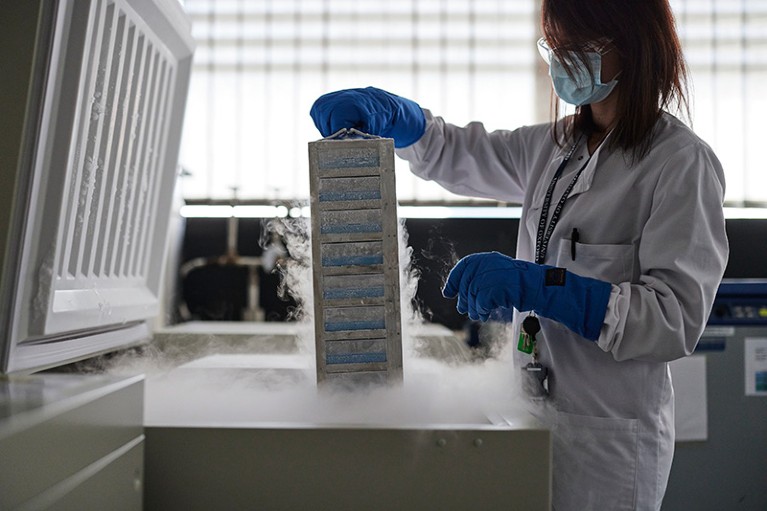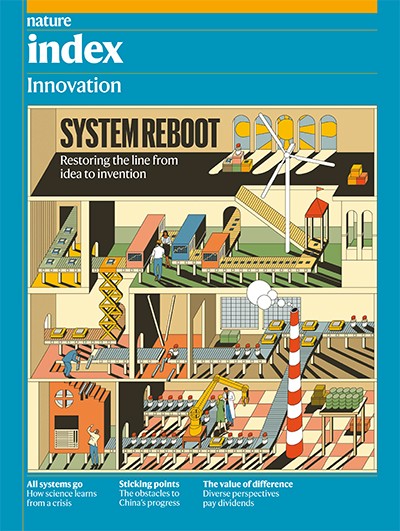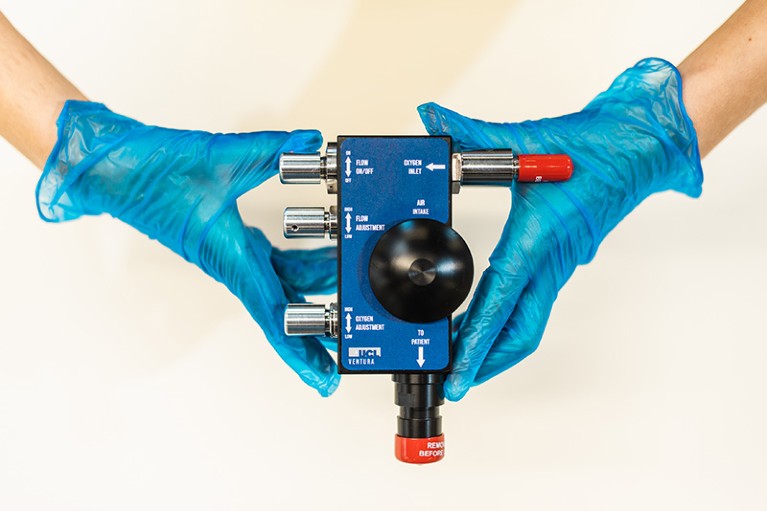
The Oxford–AstraZeneca vaccine was the result of an urgent and responsive collaboration.Credit: David Levene/Guardian/eyevine
“Never let a good crisis go to waste,” Winston Churchill is said to have once advised. In that spirit, scientists and institutions around the world used the COVID-19 pandemic to drive the development of products, technologies and approaches to innovation. “It was unique in a tragic way, and it spurred a whole new way of doing things,” says Caroline Paunov, an economist with the Organisation for Economic Co-operation and Development (OECD). “It led to a different way of thinking about cooperation.” The crisis was so urgent and pervasive that it quickly pulled together governments, companies and research institutions for the common good. But as the pandemic wanes, questions remain about how long that sense of cooperation can last and what was learnt to help cope with the next global crisis.
Vaccines are the clearest example of COVID-driven innovation. Before the pandemic, it generally took a decade or so to develop a new vaccine. But in November 2020, less than a year after the SARS-CoV-2 virus was identified, the World Health Organization counted 220 vaccine candidates. By then, three vaccines — produced by Pfizer–BioNTech, Moderna and Oxford–AstraZeneca — had been shown to be at least 90% effective in trials.

Nature Index 2022 Innovation
The rapid development of vaccines was made possible by unusually strong industry–academia partnerships, says Tomas Ulrichsen, an innovation policy researcher at the University of Cambridge, UK. The Oxford–AstraZeneca vaccine, for example, resulted from collaboration between university scientists who developed a prototype and industrial scientists who got it over the finish line. “They needed to work closely with an industrial partner to take it through large-scale clinical trials, manufacturing and distribution at scale,” Ulrichsen says. “It really highlighted what is possible when you get true collaboration — everyone working with urgency towards the same goal.”
Ulrichsen points to another COVID-19 technology that emerged from partnerships between universities and companies. Responding to a shortage of ventilators, researchers at University College London and University College Hospital worked with Mercedes High Performance Powertrains, a company in Brixworth, UK, that manufactures parts for Formula One cars, to develop the Ventura breathing aid, a mechanical device used to open the airways of critically ill patients.
Thinking fast
Table of Contents
During the pandemic, many universities stripped down the bureaucracy that limited how grants could be spent and found ways to prioritize the most potentially impactful research, Ulrichsen says. The result was a more industry-like approach to speed up the research, development and eventually the commercialization of new products. An analysis1 published in January 2021 found that, in general, universities were able to bring products to market just as rapidly as private companies.
Not all of those new approaches adopted by universities are destined to last. In a 2021 survey of 51 UK universities delivered by Ulrichsen and co-author, Leonard Kelleher, 86% of institutions said they had developed “new ways of working” to support innovation during the pandemic. But less than half of those say that the new approaches have had a significantly positive and lasting impact. “There’s a sense that as the pandemic wanes, we are reverting to our old habits and practices,” Ulrichsen says.
Publishers, too, sped up their processes. By accelerating and streamlining peer review, journals published COVID-19-related research at an unprecedented pace. An analysis2 found that, in the first half of 2020, journals took an average of just over 19 days to accept COVID-related articles compared with more than 91 days for non-COVID articles. By May of 2020, 145 publishers, institutions and journals — including Science, Nature and the Proceedings of the National Academy of Sciences — had pledged to make COVID information freely accessible without paywalls. “It was an exceptional situation, and part of the solution was open access,” Paunov says.

An engine maker and a teaching hospital joined forces to produce the Ventura breathing aid.Credit: James Tye/UCL
Preprint use also rocketed in the early days of the pandemic, including nearly 2,000 papers published on medRxiv, the health-sciences preprint server, in the month of April 2020 alone. Although some concerns emerged that faster publishing could reduce scientific rigour and accuracy, the rate of retractions was not very different from research in general. By late July 2020, 14 preprints and about 20 published articles had been retracted, withdrawn or flagged for serious concerns.
In a letter3 published in the American Journal of Medical Science in July 2022, researchers at Texas Tech University Health Sciences Center in Lubbock documented 43 retracted or withdrawn COVID-19 papers between November 2019 and August 2021. The researchers noted a “remarkable influx in COVID-19 publications and retractions”, but added that the retraction rate was similar to that seen during previous outbreaks, such as the H1N1 flu pandemic.
The COVID pandemic also inspired creativity, Paunov says. In 2020, governments, universities, non-profit organizations and other groups sponsored a series of ‘hackathons’, virtual gatherings in which teams of students, researchers and industry professionals had 24 to 48 hours to create new products to address the crisis. As Paunov notes, the EUvsVirus Hackathon, organized by the European Commission in April 2020, generated several products, including a platform for virtual learning and a prototype for a monitoring system that reduces the need for nurses to make physical contact with patients. “Normally, we would say that for innovation to work, we need people with trusted relationships who meet 55 times,” she says. “I found it fascinating that people who have never worked together can get together for a few days and come up with solutions.”
New players
The crisis also seemed to bring innovators out of the woodwork, Paunov says. Government agencies and non-profit organizations that put out calls for new ideas or products were suddenly hearing from first-time contributors. “It shows that there is a lot of innovation potential in society,” Paunov adds.
In many ways, the response of scientists and inventors to the COVID-19 crisis echoes the all-hands-on-deck approach to the Second World War, says Bhaven Sampat, an economist at Columbia University in New York City. Sampat co-wrote a paper4 for the US-based National Bureau of Economic Research that explored the parallels between the two world-altering calamities. As Sampat explains, both crises were urgent, high-stakes and unexpected. Although the Second World War inspired the Manhattan Project, a top-secret multinational effort to build an atomic weapon, COVID-19 triggered an international race to develop vaccines.
Both initiatives were ultimately successful, but the paths had distinct differences. As Sampat explains, much of the innovation in the Second World War was generated and used by a single entity: the military. “It’s much more challenging when you need civilians and firms with diverse goals and perspectives to change their behaviours or use particular technologies,” he says.
And although the Second World War inspired a united response from citizens and governments, Paunov says that sense of unity was largely missing during the pandemic. In retrospect, she says, governments and research centres could have done more to build the trust and cooperation needed to make the most of new technologies. “Things could have gone better by involving citizens more,” she says. “Once you have a vaccine, you need people who are willing to get a vaccine. Once you have a mask, you need people who are willing to wear a mask. Once you have a tracking app, you need people who are willing to use a tracking app.”
The rapid, coordinated, multi-pronged response to COVID-19 was a reminder that the standard approach to innovation is not always enough, Paunov says. And there are certainly more hard times to come. “We need to be more agile at adopting new tools and data possibilities,” she says. “We are living in a world where one crisis runs into another.”
